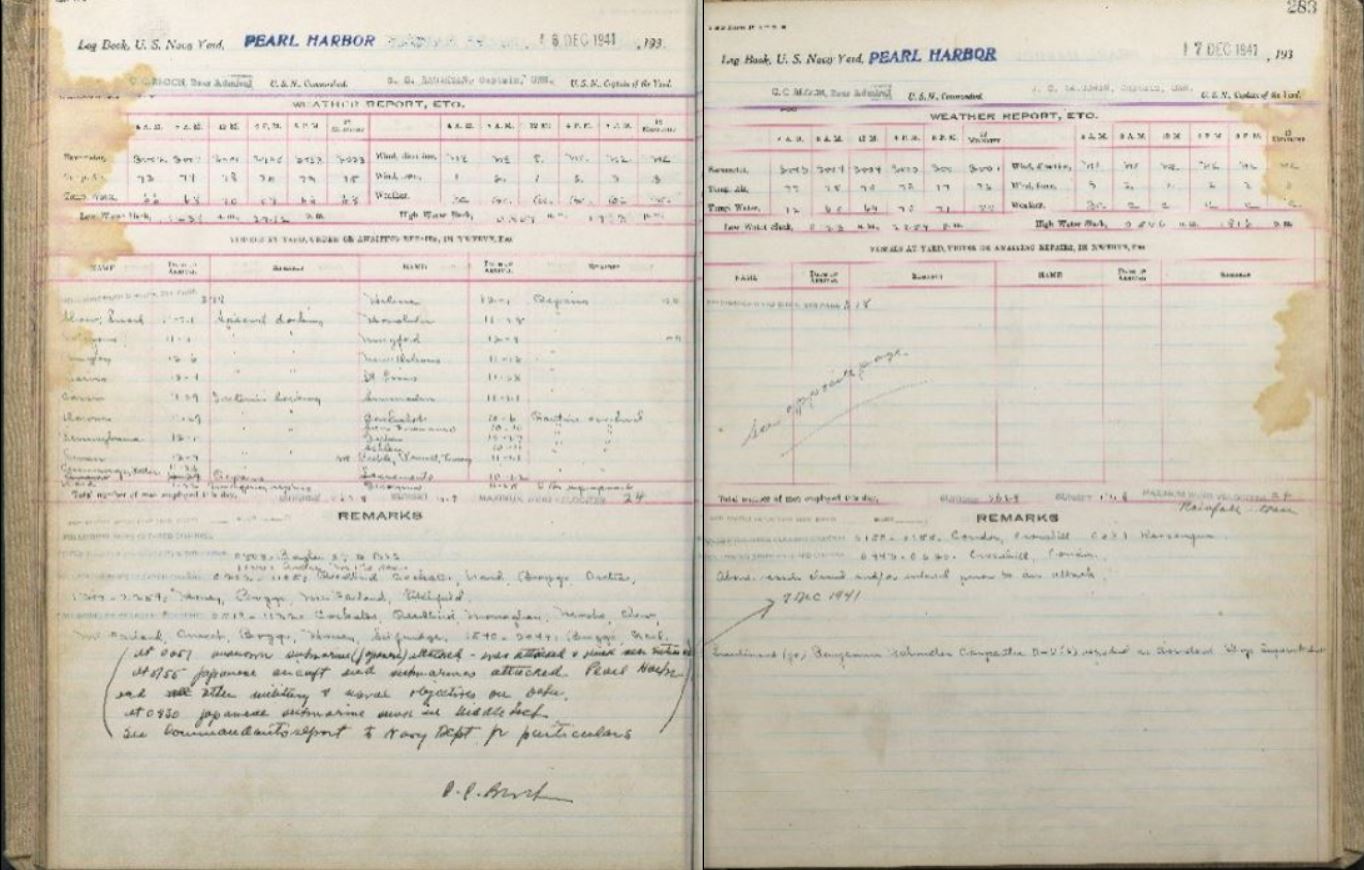Pearl Harbor Log Book from December 7, 1941, Obtained By National Archives and Now Available Online
- by Michael Stillman

Log Book entries for December 6 & 7, 1941.
“Yesterday, December 7, 1941—a date which will live in infamy—the United States of America was suddenly and deliberately attacked by the naval and air forces of the Empire of Japan.” That is one of the most notable quotes in American history, spoken by President Franklin Roosevelt to the nation shortly after the bombing of Pearl Harbor. America would soon find itself in another long and grueling war, just two decades after the end of “the war to end all wars.” It is still an official holiday, Pearl Harbor Remembrance Day, though commonly known simply as Pearl Harbor Day.
The U.S. Navy Yard at Pearl Harbor kept a regular log book of arrivals and departures, ships awaiting repairs, personnel arrivals, and weather reports. A section for “Remarks” allows for other notations. It was discarded half a century ago but was saved by an employee and retained, forgotten, until recently returned to the National Archives by the son of that employee. Their family had retained it for years, not until recently recognizing its significance.
It ranges from March 1941 – June 1942. That, of course, covers the notable date. However, this is an official log book so you wouldn't know from its notes how momentous the day was. On December 5, it notes the arrival of numerous ships, including the Arizona and Oklahoma. This was perfect timing for the Japanese. It was a Friday, and they planned to attack on Sunday, believing the Americans would not be well-prepared for battle on that day. There were 1,177 sailors and marines on the Arizona. The ship is the grave of 1,102 of them. Another 429 died on the Oklahoma, though, unlike the Arizona, that ship was salvaged.
The log book says little on December 7. It notes the arrival of Lt. Benjamin Palmeter Carpenter and the arrival of just two ships, the Condor and Crossbill. It adds, “Above vessels cleared or entered prior to an attack.” However, a note about the attack is written on the page for December 6, with an arrow pointing to the page for December 7. After some standard remarks from December 6, another hand has added, “At 0657 unknown submarine (Japanese) attacked—was attacked and sunk near entrance. At 0755 Japanese aircraft and submarines attacked Pearl Harbor and other military and naval objectives on Oahu. At 0830 Japanese submarine seen in Middle Lock.”
Not well remembered is that Japan made a second attempt to attack Pearl Harbor on March 4, 1942. This one did not work as well. Various issues reduced the number of planes reaching Hawaii to two, and heavy clouds made targeting of a site impossible. One plane's bombs fell into the ocean, the others on land but far off target. Nevertheless, there was obvious concern at the time. The log book for March 4, 1942, notes, “0045 Received report of unidentified planes approximately 50 miles away. 0050 Assumed Condition one. 1705 Three shots and whistling of projectiles heard. 1710 Received report that two fragments or bombs hit astern of Ortolan at B-3.”
By the 1970s, this log book was essentially forgotten. It had somehow made its way to Norton Air Force Base in San Bernardino, California, when someone had decided to throw it away. Oretta Kennedy was working at the base when she spotted it in a trash basket. She asked whether she could keep it was was told she could. She eventually gave it to her son, Michael William Bonds. The Washington Post reported that he kept it in a box and took it with him each time he moved. He never recognized its significance until one day when his fiancee was helping him unpack his books. It occurred to them that this might be valuable. They contacted Whitmore Rare Books and asked. Dan Whitmore told the Post he thought it might be but was concerned it could be considered government property. That was the case, and an agent from the National Archives flew to California to pick it up. Bonds did not receive a large reward, but was presented with two National Archives T-shirts. Oh well. He did the right thing.
Jim Byron, Senior Advisor to Acting Archivist Mario Rubio, said: “This special item is one of the few surviving records that helps tell the story of the ‘date which will live in infamy.’ Thanks to the efforts of an historically-conscious California couple, it is now available to the American people, allowing everyone to better appreciate their history - and especially the sacrifice and heroism of December 7, 1941.”
The log book can be viewed at the following link: catalog.archives.gov/id/552663772